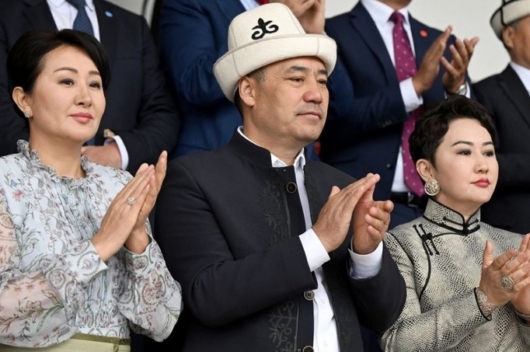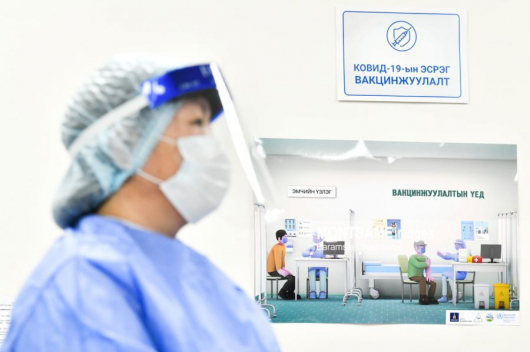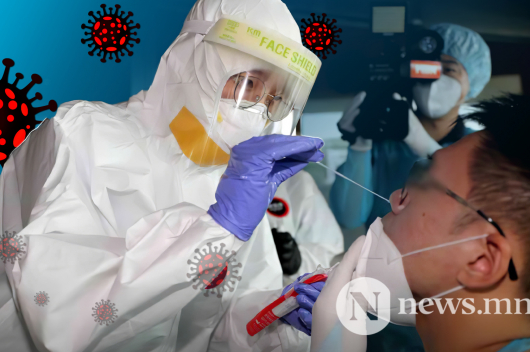Interview with Dr Sergey Diorditsa, WHO Representative to Mongolia
-At beginning of the pandemic, Mongolia sustained it under control. But in last few months COVID-19 situation in Mongolia is getting worse and number of deaths is increasing. How does WHO recap current situation of COVID-19 in Mongolia?
-Government of Mongolia has implemented actions to suppress and reduce transmission in response strategy. Increased testing, early detection, active surveillance, contact tracing, isolation, quarantine measures have been implemented effectively as comprehensive response package. Together with government we’re continuing to monitor situation. Big progress has been made in the stage assessment and application of restriction and NPI measures approved by government resolution on 21 February. Mongolia economic life has contributed to pandemic fatigue. As of last week, 99 clusters (57 of them active clusters) have been reported. Household setting had medium clusters of high frequency; cumulative proportions of reported cases is high. This is related with high density of people living in proximity, sharing living and sleeping spaces, frequent physical/direct contact. Most frequent setting is household accounted for 43.7% household, 4.7% have been reported in health facilities and 22.6% are workplace contacts.
-How does WHO cooperate with Government of Mongolia, State emergency commission, Health Ministry and what recommendations do you give them? How are they reflecting and implementing the recommendations in response measures against COVID-19?
-Mongolia has taken the whole-of-government approach. Government has been working round the clock, side by side with WHO. The system elements we’ve building over the past years has been strengthened and gained momentum. Risk assessment results revealed the high risk of insufficient control capacities with available resources. Forecasting of essential supplies has been estimated for national level and for each province. Based on risk assessment results, activation of Health Cluster and logistical forecasting, the government were able to increase domestic funding and strengthen health system. There is a management tools called incident management system where teams for planning and information, response, IPC, clinical management, logistics and supply, admin and finance. WHO has been part of the government IMS team to develop preparedness and response strategies, plans and procedures, ensure health facility preparedness and procurement of critical emergency supplies, laboratory consumables and vaccine.
-Daily number of COVID-19 cases in Mongolia is higher than other countries based on total population? In this context what measures should be taken?
-The number of cases per million population Mongolia was lower than in the rest of the world countries, but since 7 March, it higher than Asian average, and since 25 March, it higher than the world average. As of 2 April, it is 1.7 times higher than the Asian average and 3.9 times higher than the world average. In the Western Pacific Region, Mongolia now is the 5th highest incidence country after Philippines, Malaysia, Japan and Republic of Korea. Since 28 February 2021, the number of cases has increased from 2,900 to over 10,000 by 4 April. Contact tracing along with testing, isolation and care of cases is a key strategy for interrupting chains of transmission of SARS-CoV-2 and reducing COVID-19 associated mortality. Contact tracing remains an important activity in high incidence scenarios. Contact tracing activities should be targeted rather than abandoned.
-The government of Mongolia has implemented lockdown measures several times. Did the government of Mongolia consult with WHO every time for those lockdowns? Do you think the lockdown measures had impacted on the covid-19 outbreak slow down? Is it necessary to implement another lockdown?
-The first case reported in Mongolia on 10 March. However, government took strict social distancing and travel measures before the first case report. Following rapid risk assessment conducted on 6 January 2020 to assess the risk of event importation, point of entry measures have been strengthened. Mongolia applied additional IHR measures imposing travel restrictions from 2 February on Chinese nationals and travelers from China, from 26 Feb 4 countries added and flights from Korea and Japan cancelled. Flights through Russia suspended from 2 March and all incoming travelers are subjected to 2-3-week quarantine to prevent pre-symptomatic and asymptomatic transmission. Mongolia has taken early decisive actions to suppress the virus transmission. 17 ministry and agency representatives and WHO participated in the risk assessment. Since 6 January 2020, National Center for Communicable Diseases and NEMA coordinated 22 risk assessment. The risk assessment considered epidemiology and socio-economic situation. With Government resolution #45, NPI measures now based on each province stage assessment and staged, localized NPI measures using standardized process are taken by government.
-Mongolia has received the first batch of 14.400 doses of Astrazeneca vaccine through COVAX facility jointly implemented by WHO and other partners. Totally how many doses of covid-19 vaccines will be delivered through COVAX facility to Mongolia?
-COVAX plan to provide 2 billion doses in 2021 globally: almost 500 million doses have been secured for Q1 and Q2, with approximately an extra 160 million doses under negotiation. The rest will be delivered in the second half of the year.
COVAX remains fully committed to delivering vaccines as quickly as feasible. There are expected first doses to Facility Participants to be delivered in quarter 1 of 2021, with volumes increasing to more significant levels in quarter 2 and continuing to increase over the course of the year.
Mongolia is a one-member participant of COVAX Facility Advance Market Commitment (AMC) and allocated 112,800 doses of the Astrazeneca vaccine through May 2021.
Mongolia Government received 14,400 doses of Astrazeneca vaccines via COVAX facility, a partnership between the Coalition for Epidemic Preparedness Innovations, GAVI, WHO and UNICEF. This delivery as a part of first wave of arrivals. WHO and UNICEF have been technically and financially supporting the Government of Mongolia to prepare for the COVID – 19 immunization campaign.
Mongolia has been selected for participation in the first wave Pfizer vaccine distribution round and is allocated 25,740 doses and received on batch shipment on 25 March 2021.
-Mongolia launched COVID-19 vaccination campaign in February. By today, around 300,000 people had been vaccinated. When will COVID-19 situation in Mongolia get better and will number of daily cases decrease based on the status of vaccination?
-Despite the vaccination is ongoing we still need to continue and maintain wearing masks, to avoid visiting crowded places and wash hands. It should be new normal till the situation will start to improve not only in Mongolia but in all other countries till pandemic is over.
-Information related to blood clotting and severe reactions for young women caused by Astrazeneca/Oxford vaccine did spread and many countries have suspended to use it. Do you provide recommendation on how to monitor people vaccinated with Astrazeneca vaccine in Mongolia?
There are possible side effects and AEFI:
- The interim guidance has been developed on the basis of the advice issued by the Strategic Advisory Group of Experts (SAGE) on use of COVID-19 vaccines including Pfizer BionTech and Astrazeneca
- Fever, headache, dizziness, chills, tiredness, poor appetite, vomiting; redness, pain, swelling at injection site, lymphadenopathy, muscle pain, joint pain, rash can occur. These reactions will disappear within 1-3 days.
- In rare case, anaphylaxis, severe allergic reactions, encephalomyelitis, convulsion, neuritis, loss of function maybe occur.
- Health facilities must prepare to be used ready emergency kit for treatment of anaphylaxis cases.
- Co-administration of Astrazeneca vaccine with other vaccines is not recommended and other vaccines should be given 1 month apart from the vaccine. Person who has current infection of Covid-19 confirmed by PCR test can get the vaccine 6 months later.
- Immunization
-The government of Mongolia is preparing to open the border in May 2021. Do you think that number of cases which already reached three-digit number will be decreased before May?
-I cannot predict what will be the number in May. But together with MOH and NCCD we are looking and modelling different scenarios. At the same time, WHO together with UNICEF will continue to work and provide technical support to ensure that vaccination is reaching all eligible groups based on priority of risks. I was visiting yesterday together with Prime Minister, Deputy Prime Minister and Minister of health and observed the vaccination of elderly people who are together with health workers are at the most risks of COVID infection. And as I said earlier it is very important to continue contact tracing to identify places where people are infected and timely inform people of possible risks of infection, and to start treatment as soon as possible.
 3,575.44
3,575.44












Related News